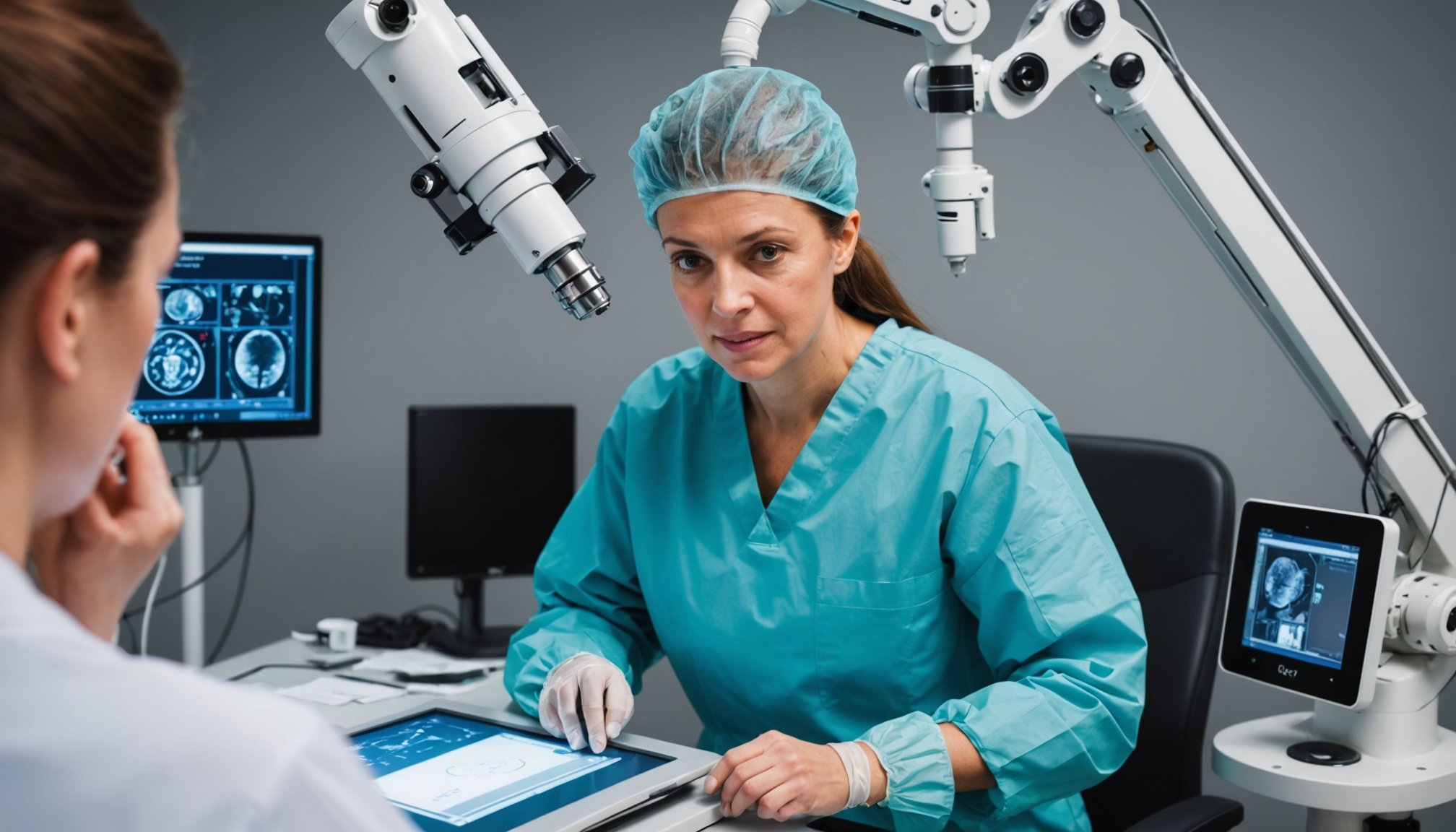Guidelines and Training Resources for UK Surgeons
The integration of robotic surgery into medical practice requires comprehensive training and adherence to best-practice guidelines. In the UK, surgeon guidelines are essential to ensuring both safety and effectiveness in robotic procedures. Leading medical bodies have established training programs and resources, facilitating expertise in this innovative field.
Continuing professional education is paramount. Surgeons can access a variety of resources, including online courses, workshops, and hands-on training modules. These programs are designed to equip them with the skills necessary for robotic surgery proficiency. Emphasis is placed on understanding robotics systems and mastering precision techniques, crucial for successful operations.
In parallel : Exploring Cutting-Edge Imaging Methods Employed by UK Radiologists for Early Cancer Diagnosis
The importance of familiarity with robot-assisted technologies can’t be overstated. As technologies evolve, surgeons must stay informed about the latest advancements, particularly those related to gynecology innovations. Regular training ensures they can apply new techniques effectively, reducing patient risks and improving outcomes.
The UK healthcare system also prioritises the development of well-rounded professionals. This means not only focusing on clinical competence but also fostering an environment that supports continuous learning and adaptation to technological changes. By maintaining a commitment to education, surgeons ensure safe, effective care for patients navigating this new frontier of medicine.
This might interest you : Personalizing Treatment for Shift Work Sleep Disorder: Insights from UK Sleep Specialists
Overview of Robotic Surgery in Gynecology
In the realm of gynecology, robotic surgery represents a pivotal advancement in medical technology, revolutionising how surgical procedures are approached. Defined by the utilisation of robotic systems to perform intricate tasks with enhanced precision, robotic surgery has emerged as a crucial tool for gynecological procedures. From hysterectomies to myomectomies, it offers significant improvements over traditional methods.
The importance of robotic surgery in gynecology lies in its minimally invasive nature, which facilitates quicker recovery and less postoperative pain. This evolution has transformed patient care, reducing hospital stays and enhancing overall patient satisfaction. Current trends indicate a rapid adoption rate of these technologies in the UK, driven by their effectiveness and benefits to both patients and healthcare providers.
As robotic surgery increasingly becomes the standard in gynecological treatments, it reflects broader trends towards innovation and optimisation in healthcare. The demand for skilled professionals capable of navigating these complex systems underscores the need for ongoing education and training. This ensures that surgeons remain at the forefront of cutting-edge healthcare solutions. Thus, robotic surgery is not merely a trend but a foundation for future medical developments in the field of gynecology.
Cutting-Edge Robotic Technologies
In the domain of gynecological surgery, technological innovations play a pivotal role in enhancing surgical efficiency and outcomes. Leading robotic systems such as the da Vinci Surgical System are at the forefront, providing advanced tools that allow surgeons to perform precise operations. These systems incorporate AI integration and precision enhancements, enabling superior performance compared to traditional methods.
Recent technology advancements include improvements in imaging capabilities, offering enhanced visual clarity. These enhancements assist surgeons in executing complex procedures with greater accuracy, thereby reducing the likelihood of complications. Furthermore, innovations in haptic feedback allow for finer manipulations during surgery, ensuring minimal invasiveness.
When comparing robotic platforms, systems such as the Senhance Surgical System offer unique features, including eye-sensing camera control and adaptive learning algorithms. This diversity allows healthcare providers to choose systems that best fit their operational needs and patient care objectives.
The integration of advanced robotics in gynecology signifies a critical evolution in medical practice. By continuing to harness these technological advancements, the field of gynecology can expect ongoing improvements in both surgical precision and patient recovery experiences. The continual enhancement of robotic systems is essential for setting new standards in surgical excellence and patient care.
Applications of Robotic Surgery in Gynecology
The realm of gynecological procedures has been greatly enhanced by robotic surgery, making significant strides in surgical applications. This advanced approach is particularly effective for minimally invasive surgeries, such as hysterectomies and myomectomies, where precision is crucial. Utilizing robotic techniques allows surgeons to perform complex operations with reduced incisions, leading to decreased recovery times and fewer complications.
The shift towards robot-assisted procedures highlights the evolution of surgical practices over time. As robotic technology continues to develop, more gynecological conditions can be treated with minimally invasive methods. This progression is not only beneficial for patients, providing them with quicker recovery and less postoperative pain, but also supports surgeons by offering better visualisation and control during operations.
Robotic platforms offer a cutting-edge solution to traditional surgical challenges, making them an invaluable asset in modern medicine. Their impact on healthcare signifies a trend towards enhancing surgical efficiency and outcomes. As adoption rates in the UK grow, the necessity for comprehensive training becomes evident. This ensures that surgeons remain adept at navigating advanced technologies, providing patients with the highest standard of gynecological care.
Success Stories and Case Studies
In the realm of robotic surgery, the compilation of notable case studies reveals a transformative impact on patient outcomes. These clinical success stories serve as a testament to the innovative applications of robotic systems in gynecology and beyond. For instance, one standout case involved a complex hysterectomy performed with remarkable precision, drastically reducing the procedure time and enhancing postoperative recovery compared to traditional methods. Such cases consistently illustrate the benefits of robot-assisted surgery in achieving higher accuracy and patient satisfaction.
Patient testimonials provide valuable insights, highlighting experiences of lessened discomfort and expedited healing. Many patients have reported minimal invasiveness and rapid returns to daily activities, attributing improvements to the precision and reliability of robotic procedures. These personal accounts bolster confidence in robotic surgery and its growing acceptance among patients.
Statistical analysis further supports the advantages observed in case studies. Comparing traditional methods with robotic approaches, studies consistently find increased success rates, characterized by lower complication occurrences and shorter hospital stays. These metrics underscore robotic surgery’s contribution to enhancing healthcare efficacy and patient safety. The wealth of evidence and expert validation captured in clinical research solidifies robotic surgery’s role in advancing medical care standards.
Advantages of Robotic Surgery
The benefits of robotic surgery extend profoundly to both patients and surgeons, creating a notable impact on medical outcomes. For patients, one of the primary advantages is the reduction in recovery times. Robot-assisted surgery often involves minimally invasive techniques, resulting in smaller incisions, less postoperative pain, and shorter hospital stays.
Surgeons also experience significant benefits. The efficiency of robotic systems enhances surgical precision, providing greater control and visibility during procedures. These systems often come equipped with features such as 3D visualisation and advanced instrument dexterity, allowing for intricate movements that might be challenging with human hands alone.
From a logistical standpoint, healthcare facilities benefit financially as well. Although the initial investment in robotic surgery can be substantial, the long-term savings for hospitals are evident. Reduced patient stay durations and lower complication rates lead to decreased costs in postoperative care. Moreover, the efficiency of robotic procedures may allow hospitals to increase patient turnover, further compensating the upfront costs.
In conclusion, integrating robotic systems into surgical practice presents numerous advantages that significantly enhance patient outcomes and operational efficiency. This dual benefit underscores why robotic surgeries are increasingly adopted despite their initial investment requirements.
Challenges and Limitations
Despite the advancements in robotic surgery, there are notable challenges and limitations that surgeons encounter. The complexity of operating sophisticated robotic systems can pose significant difficulties. These technologies necessitate extensive training and a formidable expertise level to ensure proficiency and patient safety. Therefore, robust training programs are crucial to equip surgeons with requisite skills and confidence.
Limitations of current robotic technologies include restricted tactile feedback for surgeons, making it challenging to gauge the force applied during procedures. This absence of sensory feedback requires reliance on visual cues and can lead to over-compensation or hesitation, potentially impacting surgical outcomes. Additionally, robotic systems are currently expensive, entailing high acquisition and maintenance costs, which can impede widespread adoption in lower-resourced healthcare facilities.
Moreover, adapting to the rapidly changing landscape of robotic technology means that continual education and skill updates are indispensable for healthcare providers. The healthcare community must confront these challenges through dedicated education and improving system designs to make them more intuitive and affordable. Addressing these issues is vital for leveraging robotic surgery’s full potential to enhance patient care, despite the inherent challenges these groundbreaking technologies present.
Future Developments in Robotic Surgery
The future of robot-assisted surgery holds immense promise, with exciting emerging technologies on the horizon. Among them, the integration of augmented reality (AR) and virtual reality (VR) technologies is anticipated to further enhance surgical precision. These technologies could provide surgeons with real-time, 3D visualisations of the patient’s anatomy, facilitating even more accurate and effective procedures.
In the next decade, we can expect substantial advancements in machine learning and artificial intelligence (AI), which will allow robotic systems to adapt and learn from each surgery. This capability promises to improve outcomes by continuously refining techniques and recognising patterns that enhance efficiency and safety.
There is also potential for robotics to integrate more closely with other medical fields, such as oncology and orthopaedics. As these innovations develop, we may see robots capable of performing more specialised interventions, widening the spectrum of treatments available without significantly increasing procedural risks.
Overall, the continued evolution of robotic surgery is set to revolutionise medical practices, offering greater accessibility to precise, minimally invasive procedures. As these future innovations unfold, the medical community will need to stay abreast of changes, ensuring that training programs and guidelines remain at the cutting edge of technological development.
Clinical Studies and Expert Opinions
Understanding the impact of robotic surgery requires a close examination of clinical research and expert insights. Numerous studies illustrate how these innovations enhance patient outcomes. One study highlights significant reductions in postoperative pain for patients undergoing minimally invasive robotic procedures compared to traditional surgery. Such findings underscore the tangible benefits of robot-assisted techniques, shifting the paradigm of surgical practice.
Experts in the field of gynecology frequently express optimism about the advancements in robotic systems. Their insights often focus on the potential of these technologies to minimise complications and improve recovery times. By providing surgeons with enhanced precision and control, robotic surgery is positioned as a viable alternative to conventional methods.
The continued research into robotic surgery is vital. It informs not only the development of safer and more efficient techniques but also shapes future guidelines and standards. Publications in leading medical journals frequently feature analysis and commentary from pioneers in this technology, offering critical evaluations of emerging trends and effectiveness.
Ensuring the success of robotic surgery also involves acknowledging areas for improvement. By leveraging expert opinions and rigorous clinical research, the medical field can refine these technologies to maximise their effectiveness and broaden their applications.









